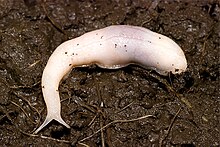Ghost slug
| Ghost slug | |
|---|---|
 |
|
| A live individual of Selenochlamys ysbryda, head end towards the lower left | |
| Scientific classification | |
| Kingdom: | Animalia |
| Phylum: | Mollusca |
| Class: | Gastropoda |
| (unranked): | clade Heterobranchia clade Euthyneura clade Panpulmonata clade Eupulmonata clade Stylommatophora |
| Superfamily: | Parmacelloidea |
| Family: | Trigonochlamydidae |
| Subfamily: | Trigonochlamydinae |
| Genus: | Selenochlamys |
| Species: | S. ysbryda |
| Binomial name | |
|
Selenochlamys ysbryda Rowson & Symondson, 2008 |
|
The ghost slug (Selenochlamys ysbryda) is a species of predatory air-breathing land slug. It is a shell-less pulmonate gastropod mollusc in the family Trigonochlamydidae.
The species was first recognised from various sites in Wales and was formally described and named in 2008 by Ben Rowson, a taxonomist at the National Museum Wales (Amgueddfa Cymru), and Bill Symondson, an ecologist at Cardiff University. It has subsequently turned up at numerous further sites in South Wales and a few sites in England, but it is believed to be an introduction in the UK, occurring mostly in gardens.
Specimens likely to be this species have also now been identified from two sites in natural mountain forest in the Crimea in Ukraine. Probably the Crimean mountains are within its native range.
This slug can reach 6.4 cm (2.5 in) in size, with its body extended. It has no eyes, and is white in colour. It is predominantly burrowing, living up to a metre underground, and rarely, at night, coming to the surface. Unlike the majority of slugs, it is a carnivore, feeding on earthworms using its blade-like teeth. Both the mantle and the breathing hole are found at the tail end of the body.
Because of the slug's white colour and nocturnal habits, and because it is so rarely seen, it was given the species name ysbryda, the word "ysbryd" meaning ghost in the Welsh language. This in turn gave rise to the common name, "ghost slug". This appears to be the first case of a species name having been taken from the Welsh language.
...
Wikipedia
